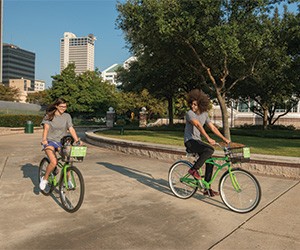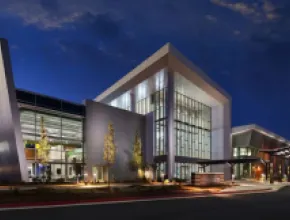From the Civil War through the Great Depression, Alabama’s roots run deep. History has woven a textured state culture that draws in visitors, and the Cotton State’s forward-thinkers have established numerous venues that inspire hope and creativity in groups.
The following nine venues reflect Alabama’s rich heritage and showcase its artistic panache to attendees.
USS ALABAMA, MOBILE
www.ussalabama.com
The USS Alabama is a South Dakota-class battleship that displaces more than 44,500 tons of water, and it makes a splash with groups as well. The ship was commissioned in 1942 and served 37 months of active duty during World War II in the Atlantic and Pacific theaters, suffering no casualties. Nowadays, it is docked in Mobile Bay, within a 175-acre military park that is open to visitors.
The vessel can accommodate large groups, with space for up to 500 people on the fantail alone.
“It is really a special place,” says Stacy Hamilton, vice president of marketing and communications for the Mobile Bay CVB. “Groups can rent out the entire battleship and walk around and see the crew’s quarters. There is also a hangar full of dozens of historical aircraft that can host great events.”
Indoors onboard the Alabama, the Wardroom, the mess cabin for high ranking commissioned officers, can accommodate up to 150 people for dinners, meetings, corporate events and parties.
Back on dry land, groups of up to 1,200 can dine underneath warplanes such as the A-12 Blackbird spy plane and the Tuskegee Airmen’s P-51 Mustang in the 36,000-square-foot Aircraft Pavilion.
CENTER FOR THE LIVING ARTS, MOBILE
www.space301.com
The Center for the Living Arts is a forward-thinking museum and venue that in 2012 unveiled its Memory Project, a nine-month program encompassing both visual and performing arts that hope to inspire a national model for community building through art.
The first phase examined the intersection between personal and collective memory in the Gulf Coast and beyond.
One of the venues hosting the Memory Project is also available to planners. Space 301 is a multilevel area with rotating art exhibits on the ground floor and reception space upstairs.
Hamilton speaks to the space’s versatility.
“We’ve seen all different types of set-ups in Space 301, it’s basically a blank canvas, and the staff is incredibly creative,” she says.
An outdoor patio overlooks the Mobile skyline. The center is also home to the Saenger Theater, where the Mobile Symphony performs. PageBreak
CIVIL RIGHTS INSTITUTE, BIRMINGHAM
www.bcri.org
Few venues convey a more powerful message for a better tomorrow than Birmingham’s Civil Rights Institute. “Chronicling the past to inspire the future,” the institute spotlights an assortment of exhibits, both traveling and permanent, and aims to unite communities and overcome the city’s infamous history of racial division.
“The self-guided tour is absolutely fabulous,” says Barry Hoehn, director of sales for the Greater Birmingham CVB. “When I take visitors there I can’t get them to leave. It takes your breath away and gives great historical background to the Civil Rights Movement.”
The rotunda can accommodate a reception of up to 300, and a lecture room seating 20 is available for small events and classes.
The institute is located near 16th Street Baptist Church, a National Historic Monument that was the target of a racially motivated bombing in September 1963, and Kelly Ingram Park, where Rev. Martin Luther King and other civil rights leaders staged crucial demonstrations.
All of these sites are expected to be popular destinations in the upcoming year.
“2013 is the 50th anniversary of the civil rights movement in Birmingham, so the city is expecting a lot of visitors,” Hoehn says.
According Hoehn, the city is also looking forward to the opening of a new downtown entertainment district in spring 2014.
“It’s one thing that we’ve been lacking,” he says.
SLOSS FURNACES, BIRMINGHAM
www.slossfurnaces.com
Drawn to the area by iron ore buried in Red Mountain, the workers that founded Sloss Furnaces played a major role in the early boom in Birmingham’s population.
The 32-acre blast furnace that produced iron for 100 years is now a National Historic Landmark and has been converted into a museum of history and industry that preserves a collection of machinery and buildings, showcasing Birmingham’s role in America’s growth as an industrial nation during the 20th century.
The venue is also rumored to be haunted by a former foundryman and hosts spooky annual Halloween festivities.
Planners can host up to 900 guests in the large covered casting shed, and 250 people can gather in the water tower area, as well as various outdoor patios, ponds and the furnace apron, which accommodate everything from large concerts to small fundraisers and private parties.
Guided group tours are available, and on select dates in the spring and fall visitors can participate in iron pours. PageBreak
HAMPSTEAD, MONTGOMERY
www.hampsteadliving.com
The 416-acre community of Hampstead was designed around the “new urbanist” principles of sustainability and mixed-use, combining residential areas with retail, education, restaurants and offices. Located within the city of Montgomery, the neighborhood welcomes groups to its vibrant and pedestrian-friendly town center.
“Good design [both architectural and town planning] is a critical component of Hampstead,” says Anna Lowder, director of design and development. “The Town Square can be elegant and dramatic, or tented to offer indoor and outdoor options.”
The intimate Hampstead Club Room can accommodate small receptions and gatherings of up to 70 and offers 360-degree views from the top of the Hampstead Tower. Another option for planners is Hampstead Farm, a classic red barn venue with lawn event space.
“The farm offers a rustic setting that can take on the personality of the organizer very easily,” Lowder says.
JASMINE HILL GARDENS & OUTDOOR MUSEUM, MONTGoMERY
www.jasminehill.org
When the weather is right for outdoor events, the Jasmine Hill Gardens offer planners a scenic setting in the southern tip of the Appalachian mountains. The property spans more than 20 acres, and something is always in bloom; from marigolds, hydrangeas and water lilies in June to winter blooming azaleas in December and Japanese cherry trees in March.
The nonprofit venture was founded by Benjamin and Mary Fitzpatrick more than 20 years ago, and furthered by over 20 trips to Greece to study the culture and collect works of art. Their idea for the garden took root during the Great Depression and has since grown into a charming venue filled with flowers and trees and dotted by Greek and Roman-inspired statues and tributes to the Olympic Games. More than 40 statues, a mix of replicas and originals, accent the plants, including a replica of the Grecian Temple of Hera in Olympia where the Olympic flame is lit before it travels around the globe.
In 1995, a major expansion included new statuary acquisitions and the construction of the Olympian Center, which can accommodate up to 300 people in its Grand Hall. Other meeting spaces include a second-floor conference room seating 25, and the Cottage, with seating for up to 70 in six rooms.
The meandering and colorful garden pathways are perfect for cocktail parties and corporate receptions.
Garden tours of “Alabama’s little corner of Greece” are available for groups larger than 20 people. PageBreak
JULES COLLINS SMITH MUSEUM OF FINE ART, AUBURN
www.jcsm.auburn.edu
Set on the Auburn University campus, the Jules Collins Smith Museum of Fine Art is a unique venue option for groups looking to explore the city’s cultural side. Event spaces include the lobby, grand gallery, an open terrace and cafe.
“The museum hosts a lot of receptions and the setting is gorgeous,” says Cindy Pugh, sales manager for the Auburn/Opelika CVB. “It’s a beautiful space with a wonderful cafe, and there’s even a private pond. Exhibits change frequently, if planners want to schedule around that.”
A giant glass chandelier designed by artist Dale Chihuly dominates the museum’s rotunda. More than 30 feet across and weighing more than 2,000 pounds, the piece is made of more than 600 pieces of glass in a variety of hues.
“It’s a great venue for a party,” Pugh says. “Groups often bring in music, and in the springtime they can overflow outside and onto the terrace.”
Near the museum is the Hotel at Auburn University, with 22,000 square feet of renovated meeting space.
“Planners like to come to Auburn because we have two nice conference hotels,” Pugh says, mentioning both the university hotel and the Auburn Marriott Opelika. “Because of this we see a variety of associations and retreats come to town.”
NUNN-WINSTON HOUSE, AUBURN
www.auburnalabama.org
The historic Nunn-Winston house is available for rentals, tours, receptions, garden parties and meetings. The former home of Samuel Nunn, one of the earliest settlers of Auburn, the one-story home is a quintessential example of Antebellum Greek Revival architecture. The home was later sold to Thomas Harris Winston, a wounded Civil War veteran, and it remained in his family until the 1980s.
In 1996, the house was relocated from its original location on South Gay Street to Kiesel Park, the city’s largest park, which offers walking trails, ponds and pavilions and can accommodate outdoor group events.
“It feels like you’re miles out into the country but you’re still in Auburn,” Pugh says.
ROSENBAUM HOUSE, FLORENCE
www.wrightinalabama.com
The only Frank Lloyd Wright structure in the state of Alabama, the Rosenbaum House is now a museum filled with original furnishings. Built in 1939, the house was designed in Wright’s Usonian style, which was envisioned as a low-cost option for middle-income families during the era.
Originally owned by Stanley and Mildred Rosenbaum of Florence, the house measured 1,540 square feet, until another 1,084 square feet was added as the family grew to include four sons. The city of Florence purchased the house in 1999 and undertook extensive restorations to preserve the landmark.
The historic home can accommodate group tours, and according to Libby Jordan, director of cultural tourism for Florence-Lauderdale Tourism, groups can arrange a pre-tour cocktail party on the lawn.






